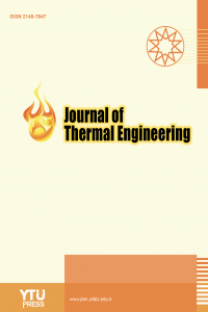COMPARISON STUDY BETWEEN THEORETICAL ANALYSIS AND ARTIFICIAL NEURAL NETWORK OF THE CAPILLARY TUBE
___
- [1] Sainath, Kasuba, T. Kishen Kumar Reddy, and Suresh Akella. "Optimization of capillary tube dimensions using different Refrigerants for 1.5 ton mobile air conditioner." Case Studies in Thermal Engineering 16 (2019): 100528. https://doi.org/10.1016/j.csite.2019.100528.
- [2] Ajayi, Oluseyi O., Dorothy E. Ibia, Mercy Ogbonnaya, Ameh Attabo, and Agarana Michael. "CFD analysis of nanorefrigerant through adiabatic capillary tube of vapour compression refrigeration system." Procedia Manufacturing 7 (2017): 688-695. https://doi.org/10.1016/j.promfg.2016.12.102.
- [3] Mittal, M. K., Ravi Kumar, and Akhilesh Gupta. "Numerical analysis of adiabatic flow of refrigerant through a spiral capillary tube." International Journal of Thermal Sciences 48, no. 7 (2009): 1348-1354. https://doi.org/10.1016/j.ijthermalsci.2009.01.003.
- [4] Wang, Jing, Feng Cao, Zhizhong Wang, Yuanyang Zhao, and Liangsheng Li. "Numerical simulation of coiled adiabatic capillary tubes in CO2 transcritical systems with separated flow model including metastable flow." International journal of refrigeration 35, no. 8 (2012): 2188-2198. https://doi.org/10.1016/j.ijrefrig.2012.07.012.
- [5] Garcıa-Valladares, O., C. D. Perez-Segarra, and A. Oliva. "Numerical simulation of capillary-tube expansion devices behaviour with pure and mixed refrigerants considering metastable region. Part II: experimental validation and parametric studies." Applied thermal engineering 22, no. 4 (2002): 379-391. https://doi.org/10.1016/S1359-4311(01)00097-7.
- [6] Wongwises, Somchai, and Mathurose Suchatawut. "A simulation for predicting the refrigerant flow characteristics including metastable region in adiabatic capillary tubes." International journal of energy research 27, no. 2 (2003): 93-109. https://doi.org/10.1002/er.860.
- [7] García-Valladares, O. "Numerical simulation of non-adiabatic capillary tubes considering metastable region. Part I: Mathematical formulation and numerical model." International Journal of Refrigeration 30, no. 4 (2007): 642-653. https://doi.org/10.1016/j.ijrefrig.2006.08.015.
- [8] Heimel, Martin, Wolfgang Lang, and Raimund Almbauer. "Performance predictions using Artificial Neural Network for isobutane flow in non-adiabatic capillary tubes." International journal of refrigeration 38 (2014): 281-289. doi.org/10.1016/j.ijrefrig.2013.08.018.
- [9] Vinš, Václav, and Václav Vacek. "Mass flow rate correlation for two-phase flow of R218 through a capillary tube." Applied thermal engineering 29, no. 14-15 (2009): 2816-2823. https://doi.org/10.1016/j.applthermaleng.2009.02.001.
- [10] Islamoglu, Yasar, Akif Kurt, and Cem Parmaksizoglu. "Performance prediction for non-adiabatic capillary tube suction line heat exchanger: an artificial neural network approach." Energy conversion and management 46, no. 2 (2005): 223-232. https://doi.org/10.1016/j.enconman.2004.02.015.
- [11] Duch, Włodzisław. "Coloring black boxes: visualization of neural network decisions." In Proceedings of the International Joint Conference on Neural Networks, 2003., vol. 3, pp. 1735-1740. IEEE, 2003. https://doi.org/10.1109/IJCNN.2003.1223669.
- [12] Stoecker, W. F., and W. N. Jones. "Refrigeration and Air Conditioning. The McGaw-Hill." Inc. New York (1982).
- Yayın Aralığı: 6
- Başlangıç: 2015
- Yayıncı: YILDIZ TEKNİK ÜNİVERSİTESİ
Ahmed Ramadhan Al-Obaidi, Basim Freegah, Ammar A. Hussain
Chirag Dave, Prajwal Dandale, Kushagra Shrivastava, Dashrath Dhaygude, Kavi Rahangdale, Nilesh More
Kamal Amghar, Abdelkader Filali, Mohamed Ali Louhibi, Hicham Bouali, Najim Salhi, Merzouki Salhi
Rahul Kumar, Sujit Kumar Verma
Anshika Rani, Ravi Kant, S. Suresh, Anil Kumar
Salah H. Abid Aun, Safaa A. Ghadhban, Kadhum A. Jehhef
Rajesh Arora, Kudzanayi Chiteka, S. N. Sridhara
PHYSICAL EFFECTS OF VARIABLE FLUID PROPERTIES ON GASEOUS SLIPFLOW THROUGH A MICRO-CHANNEL HEAT SINK
